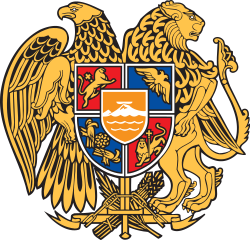Mer Hayrenik
"Mer Hayrenik" (Armenian: Մեր Հայրենիք, pronounced [mɛɾ hɑjɾɛnikʰ]; 'Our Fatherland') is the national anthem of Armenia. Barsegh Kanachyan composed the music, while the lyrics were authored by Mikayel Nalbandian. First adopted in 1918 as the anthem of the short-lived First Republic of Armenia, it was subsequently banned after the country was invaded and incorporated into the Soviet Union. Following the dissolution of the USSR and the restoration of sovereignty in 1991, the song was re-adopted as the national anthem of the newly independent state, albeit with slightly modified lyrics.
| English: 'Our Fatherland' | |
|---|---|
| Մեր Հայրենիք | |
 The Armenian emblem. | |
National anthem of | |
| Lyrics | Mikael Nalbandian, 1861 |
| Music | Barsegh Kanachyan |
| Adopted | 1918 |
| Readopted | 1991 |
| Relinquished | 1922 |
| Audio sample | |
"Mer Hayrenik" (Instrumental)
| |
History
Composition and first republic (until 1920)
The lyrics of Mer Hayrenik were derived from The Song of an Italian Girl, a poem written by Mikael Nalbandian in 1861.[1][2] (Armenian: Իտալացի աղջկա երգը, romanized: Italats’i aghjka yergy),[3] it is more well known by its incipit, Mer Hayrenik ("Our Fatherland").[2][4] In the early 20th century,[1] the music was composed by Barsegh Kanachyan.[3] Subsequently, both the lyrics and music were adopted as the national anthem of the First Republic of Armenia, which briefly existed from 1918 to 1920.[3][5]
Soviet era (1920–1991)
The Red Army invaded Armenia in November 1920, in spite of the Treaty of Sèvres – which granted the country international recognition as a sovereign state – having been signed only three months earlier.[6] In 1922, it was absorbed into the Transcaucasian Socialist Federative Soviet Republic (TSFSR), together with Azerbaijan and Georgia, and the TSFSR subsequently became part of the Soviet Union at the end of that same year.[7] As an unmistakable symbol of Armenian nationalism, Mer Hayrenik was outlawed by the Bolshevik authorities.[2][5] In its place, the Anthem of the Armenian Soviet Socialist Republic was utilized from 1944 onwards.[8][9] Because of this, Mer Hayrenik took on a new status as a protest song against Soviet rule during this time.[5]
Restoration of sovereignty and beyond (1991–present)
Mer Hayrenik was reinstated as Armenia's national anthem on 1 July 1991[3] by the constituent republic's Supreme Soviet.[10] The lyrics are not identical to the 1918 version, however, because several of the words have been modified.[1][11] As an intrinsic element of civic education in Armenia, the anthem is one of several national symbols which feature prominently in the classrooms of the country's schools. By dignifying the song in this manner, teachers reckon that this "encourage[s] students to sing the national anthem every day".[12]
A debate of the national anthem was a question in the Armenian Parliament in 2006 and 2019. The new government had called for the restoration of the Soviet era anthem with newer lyrics in its place.[13]
Lyrics
Current text
Note that the last two lines in each verse are repeated.
| Original Armenian | Romanisation | IPA transcription | English translation |
|---|---|---|---|
Մեր Հայրենիք, ազատ անկախ, |
Mer Hajrenikh, azat ankax, |
[mɛɹ hɑjɾɛnikʰ | ɑzɑt ɑnkɑχ |] |
Our Fatherland, free, independent, |
Original text
Mer Hayrenik is based on the first, third, fourth and sixth stanzas of the original poem The Song of an Italian Girl.
| Anthem text in Armenian | English translation | Poem text in Armenian (1st, 3rd, 4th and 6th stanzas) |
|---|---|---|
Մեր Հայրենիք, ազատ անկախ, |
Our Fatherland, free, independent, |
Մեր հայրենիք, թշուառ, անտէր, |
| National anthems of Armenia | ||||||
|---|---|---|---|---|---|---|
|
||||||
Context of lyrics
The lyrics of "Mer Hayrenik" promotes the worthiness of "dying for the freedom" of Armenia.[14] Its discussion of death, however, has led several commentators to complain that the anthem is overly "wimpy" and "gloomy".[5][15] Specifically, some members of the National Assembly are of the opinion that the song – written at the time of the first fight for independence – does not accurately reflect the present era of triumph and success.[16] However, none of the proposals to replace "Mer Hayrenik" have come to fruition,[17] as the Armenian Revolutionary Federation (Dashnaktsutyun) – which were part of the coalition government[5] – have so far resisted efforts to change the national anthem.[5][15]
In popular culture
The title of the national anthem is used as the name of a television channel for Armenian expatriates residing in Russia. Mer Hayrenik TV is based in the city of Novosibirsk, the administrative centre of both Novosibirsk Oblast as well as the Siberian Federal District.[18]
Notes
- The Romanization is based on the 1913 HMB and 1993 KNAB transliteration systems, with slight modifications.
References
- Waters, Bella (1 September 2008). Armenia in Pictures. Twenty-First Century Books. p. 69. ISBN 9780822585763. Retrieved 29 April 2017.
- Adalian, Rouben Paul (13 May 2010). Historical Dictionary of Armenia. Scarecrow Press. p. 469. ISBN 9780810874503. Retrieved 28 April 2017.
- Ghazanchyan, Siranush (15 June 2016). "June 15 is the day of Armenian state symbols". Public Radio of Armenia. Archived from the original on 28 April 2017. Retrieved 28 April 2017.
- Hacikyan, Agop Jack, ed. (2005). The Heritage of Armenian Literature: From the eighteenth century to modern times. 3. Wayne State University Press. p. 293. ISBN 978-0814332214. Retrieved 29 April 2017.
- Parsons, Robert (24 August 2006). "CIS: Armenia Latest To Agonize Over Anthem". Radio Free Europe/Radio Liberty. Broadcasting Board of Governors. Archived from the original on 27 April 2017. Retrieved 28 April 2017.
- "Armenia – History". Worldmark Encyclopedia of Nations (12th ed.). Thomson Gale. 2007. Retrieved 28 April 2017.
- Dowsett, Charles James Frank; Suny, Ronald Grigor (14 March 2017). "Armenia – History". Encyclopedia Britannica. Encyclopedia Britannica, Inc. Retrieved 28 April 2017.
- "Aram Khachaturian". Encyclopedia Britannica. Encyclopedia Britannica, Inc. 14 December 2000. Retrieved 28 April 2017.
- "Aram Khachaturian". BBC Music. BBC. Retrieved 28 April 2017.
- "About Armenia – General Information". Government of the Republic of Armenia. Archived from the original on 28 April 2017. Retrieved 28 April 2017.
- "Armenia". The World Factbook. CIA. 12 January 2017. Retrieved 29 April 2017.
- Terzian, Shelley (2016). "International Influences on Post-Soviet Armenian Education". European Journal of Education. 51 (2): 292–293. doi:10.1111/ejed.12143. (registration required)
- https://eurasianet.org/armenias-new-authorities-debate-changing-national-anthem
- McDonnell, Daniel (2 September 2010). "Euro 2012 diary: Armenians' catchy anthem may raise roof". Irish Independent. Dublin. Retrieved 29 April 2017.
- Mkrtchyan, Gayane (4 March 2015). "National Symbols: Artists again raise questions over Armenian anthem, coat of arms". ArmeniaNow. Archived from the original on 11 July 2015. Retrieved 29 April 2017.
- "National Assembly Debates the Draft on the National Anthem of the Republic of Armenia". National Assembly of the Republic of Armenia. 28 November 2006. Archived from the original on 29 April 2017. Retrieved 29 April 2017.
- Abrahamyan, Gayane (4 December 2012). "Symbols of Debate: Initiative underway to restore historic Coat of Arms and anthem". ArmeniaNow. Archived from the original on 6 July 2015. Retrieved 29 April 2017.
- Ter-Matevosyan, Vahram; Danielyan, Hamazasp; Sisserian, Serge-Varak; Kankanyan, Nina; Shorjian, Nayiri (2017). "Institutions and identity politics in the Armenian diaspora: the cases of Russia and Lebanon". Diaspora Studies. 10 (1): 78. doi:10.1080/09739572.2016.1239436. (registration required)
